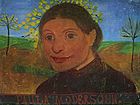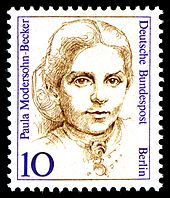- Paula Modersohn-Becker
-
 Paula Modersohn-Becker
Paula Modersohn-Becker
Paula Modersohn-Becker (February 8, 1876 – November 21, 1907) was a German painter and one of the most important representatives of early expressionism. In a brief career, cut short by an embolism at the age of 31, she created a number of groundbreaking images of great intensity.
Contents
Life and work

Paula Becker was born and grew up in Dresden-Friedrichstadt. She was the third child of seven children in her family. Her father who was the son of a Russian university professor, was employed with the German railway. He and Modersohn-Becker's mother, who was from an aristocratic family, provided the children a cultured and intellectual environment in the house hold.
In 1888 her parents moved from Dresden to Bremen. While visiting an aunt in London, England, she received her first instruction in drawing. Apart from her teacher's training in Bremen in 1893–1895, Paula took private instruction in painting. In 1896 she participated in a course for painting and drawing sponsored by the "Verein der Berliner Künstlerinnen" (Union of Berlin Female Artists) which offered art studies to women.
At the age of 22, she encountered the artistic community of Worpswede. In this "village", artists such as Fritz Mackensen (1866–1953) and Heinrich Vogeler (1872–1942) had retreated to protest against the domination of the art academy and life in the big city. At Worpswede, Paula Modersohn-Becker took painting lessons from Mackensen. The main subjects were the life of the farmers and the northern German landscape. At this time she began close friendships with the sculptor Clara Westhoff (1875–1954) and the poet Rainer Maria Rilke (1875–1926). She also fell in love during this period, and in 1901 she married a fellow Worpswede painter, Otto Modersohn. In marrying Otto, she also became a stepmother to Otto's daughter, Elsbeth Modersohn, the child from his first marriage to Helene Modersohn, then deceased.
Between 1900 and 1907, Paula made several extended trips to Paris for artistic purposes, sometimes living separately from her husband, Otto. During one of her residencies in Paris, she took courses at the École des Beaux-Arts. She visited contemporary exhibitions often, and was particularly intrigued with the work of Paul Cézanne. Other post impressionists were especially influential, including Vincent van Gogh and Paul Gauguin. Fauve influences may also appear in such works as Poorhouse Woman with a Glass Bottle. The influence by the work of French painter, Jean-François Millet, who was widely admired among the artists in the Worpswede group, may be seen in such pieces as her 1900 Peat Cutters.
In her last trip to Paris in 1906, she produced a body of paintings from which she felt very great excitement and satisfaction. During this period of painting, she produced her initial nude self-portraits (something surely unprecedented by a female painter) and portraits of friends such as Rainer Maria Rilke and Werner Sombart. Some critics consider this period of her art production to be the strongest and most compelling.
 Paula with Mathilde, November 1907 (days before Paula's death)
Paula with Mathilde, November 1907 (days before Paula's death)
In 1907, Paula Modersohn-Becker returned to her husband in Worpswede. Their relationship, which had been particularly strained in 1906, had taken a turn towards improvement. Paula's long-lived wish to conceive and bear a child was fulfilled. Her daughter Mathilde (Tillie) Modersohn was born on November 2, 1907. Paula and Otto were joyous. Sadly, the joy became soon overshadowed by tragedy, as Paula Modersohn-Becker died suddenly in Worpswede on November 20 from an embolism.
In 1908, Rainer Maria Rilke wrote the renowned poem, "Requiem for a Friend", in Paula's memory. The poem was born of the imprint that Paula's life, death and friendship left upon Rilke.
Legacy
Her daughter Tillie (1907–1998) founded the Paula Modersohn-Becker-Foundation (Paula Modersohn-Becker-Stiftung) in 1978.
A 1988 German stamp had her face on it.
Gallery
See also
References
The initial English site is a translation of the corresponding German Wikipedia site from 6/20/2005
Bibliography
- Marina Bohlmann-Modersohn: Paula Modersohn-Becker. Eine Biographie mit Briefen. 3. Auflage. Knaus, Berlin 1997, ISBN 3-8135-2594-5
- Günther Busch, Liselotte von Reinken, Arthur S. Wensinger, Carole Clew Hoey: Paula Modersohn-Becker, The Letters and Journals. Northwestern University Press, 1990.
- Anne Higonnet: "Making Babies, Painting Bodies: Women, Art, and Paula Modersohn-Becker's Productivity." Woman's Art Journal, vol. 30, no. 2 (2009):15-21, illus.
- Paula Modersohn-Becker: The Letters and Journals of Paula Modersohn-Becker. Translated & annotated by J. Diane Radycki. Introduction by Alessandra Comini. Epilogue of poetry by Rainer Maria Rilke (Requiem, 1908, translated by Adrienne Rich & Lilly Engler) and by Adrienne Rich ("Paula Becker to Clara Westhoff", 1975–76). Metuchen, N.J., & London: The Scarecrow Press, Inc., 1980. ISBN 0-8108-1344-0
- Paula Modersohn-Becker, Sophie Dorothee Gallwitz: Eine Künstlerin: Paula Becker-Modersohn. Briefe und Tagebuchblätter. Kestner-Gesellschaft, Hanover 1917
- Gillian Perry: Paula Modersohn-Becker: Her Life and Work. Harper & Row 1979.
- Diane Radycki: "American Women Artists in Munich, or Die Frauen ohne Schatten." In: American Artists in Munich: Artistic Migration and Cultural Exchange Processes, eds. Christian Fuhrmeister, Hubertus Kohle and Veerle Thielemans, pp. 109–24, illus. Modersohn-Becker & O'Keeffe. Berlin, München: Deutscher Kunstverlag, 2009. ISBN 978-3-422-06833-9
- Diane Radycki: "Paula Modersohn-Becker: The Gendered Discourse in Modernism." Ph.D.dissertation, Harvard University, 1993 (readers: Konrad Oberhuber and Norman Bryson). UMI 93-31,015.
- Diane Radycki: "Pictures of Flesh: Modersohn-Becker and the Nude." Woman's Art Journal, vol. 30, no. 2 (2009):3-14, illus. http://home.moravian.edu/users/art/medjr01/
- Diane Radycki: "Pretty/ Ugly: Morphing Paula Modersohn-Becker and Marie Laurencin." Make, no. 72 (1996):19-21, illus.
- Rainer Stamm: "Paula Modersohn-Becker and the Body in Art." Woman's Art Journal, vol. 30, no. 2 (2009):22-4, illus.
- Monica J. Strauss: "Helen Serger's Galerie La Boetie: Paula Modersohn-Becker on Madison Avenue." Woman's Art Journal, vol. 30, no. 2 (2009):32-5, illus.
- Eric Torgersen: Dear Friend: Rainer Maria Rilke and Paula Modersohn-Becker. Northwestern University Press, 1998.
External links
- Paula Modersohn-Becker Museum in Bremen
- Otto Modersohn Museum in Fischerhude
- "Pictures of Flesh: Modersohn-Becker and the Nude" Article by Dr. Diane Radycki
Categories:- 1876 births
- 1907 deaths
- German painters
- Deaths in childbirth
- Expressionist painters
- German women artists
- People from Dresden
- Women painters
Wikimedia Foundation. 2010.
















